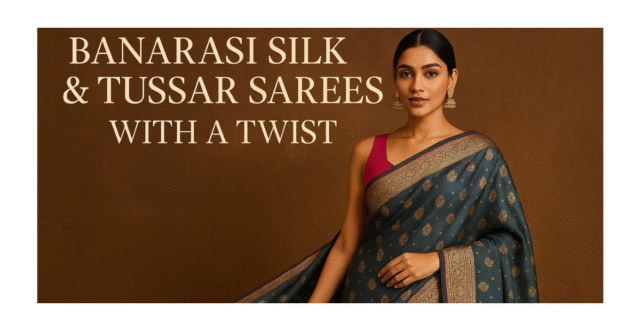In the vibrant world of traditional Indian textiles, few garments capture the essence of luxury and culture like Banarasi Silk Sarees. Woven with rich textures, intricate motifs, and often infused with gold or silver zari, these sarees have long been symbols of elegance and timeless charm. Rooted in centuries of craftsmanship, they continue to evolve, adapting to the tastes of contemporary wearers while preserving their regal heritage. Today, modern interpretations of these sarees are blending classic weaves with fresh silhouettes, innovative styling, and minimal embellishments—creating a perfect balance of tradition and trend.
The Modern Revival of a Regal Legacy
Banarasi sarees are known for their grandeur, but modern versions bring a sense of understated sophistication. Rather than heavy borders and dense embroidery, today’s versions often feature sleek patterns, soft pastel shades, and lightweight weaves—ideal for both festive and casual settings. Fashion-forward consumers are leaning towards minimalist versions that still carry the same grandeur but in a more wearable format.
The traditional wedding-only narrative of Banarasi sarees is also shifting. These sarees are now seen at office events, dinners, and casual get-togethers—styled with crop tops, jackets, or even sneakers for a fusion edge. This contemporary twist allows younger generations to appreciate the artistry while resonating with current fashion sensibilities.
Blending Weaves: Styling With Contrast
One of the biggest style movements today is mixing different types of textiles within a single look. Banarasi silk paired with lighter, matte-finish fabrics creates a unique visual balance. Imagine draping a Banarasi saree with a linen blouse or layering it with a cotton shrug—an elegant contradiction that adds flair and character.
Another popular twist is to break away from the monotone look. Stylists now recommend pairing bright Banarasi sarees with contrast-colored blouses or using belts, scarves, and statement jewelry to give a personalized touch. These styling hacks turn a traditional garment into a fashion-forward outfit that’s perfect for modern wardrobes.
The Subtle Allure of Tussar Silk
While Banarasi silks command attention with their richness, Tussar Silk Sarees offer a quieter, earthy sophistication. Known for their natural golden sheen and slightly coarse texture, Tussar sarees are ideal for those who appreciate subtlety and raw elegance. These sarees are often handwoven and come in muted, organic shades—perfect for intimate occasions, cultural events, or even as graceful everyday wear.
Tussar silk, being lightweight and breathable, also offers more comfort for long hours of wear. Whether adorned with hand-painted motifs, tribal designs, or minimalist patterns, it holds a unique aesthetic appeal that’s grounded in tradition yet beautifully adaptable to modern fashion. The irregularities in the weave make every piece unique—a characteristic increasingly valued by those who appreciate slow, sustainable fashion.
Tussar x Banarasi: A Match Made in Textile Heaven
One of the emerging trends in the world of ethnic fashion is the fusion of different weaving traditions. Designers and weavers are now combining the richness of Banarasi motifs with the muted base of Tussar silk. The result? A saree that captures the best of both worlds—opulence with restraint.
These hybrid sarees often feature Banarasi-style borders or pallu on a Tussar base, creating a contrasting texture and tonal play that feels both innovative and respectful of traditional techniques. Such pieces are ideal for women who want a statement garment without the heaviness of full zari work.
Even for those who prefer to keep the pieces separate, the combination of a Banarasi saree and a Tussar blouse (or vice versa) is becoming a creative way to refresh the classic six-yard drape. With just a little imagination, one can create countless looks from these timeless fabrics.
Embracing Conscious Fashion
Another reason why these weaves are trending again is the shift toward sustainable and ethical fashion. Both Banarasi and Tussar silk are often handwoven by skilled artisans, and their production supports local craftsmanship and heritage textiles. When you invest in these sarees, you’re not just buying clothing—you’re supporting a community, a culture, and a history.
As fashion becomes more inclusive of heritage and craftsmanship, sarees like these are gaining the recognition they deserve not only in India but also internationally. Many are now being styled in ways that work across borders, proving that traditional fabrics can hold their own on global platforms.
Final Thoughts
Banarasi and Tussar silk may come from different weaving traditions, but they share a deep cultural richness and artisanal beauty that transcends trends. The new-age approach to draping, mixing, and styling these sarees proves that heritage fashion isn’t about being stuck in the past—it’s about reinterpreting the past to suit the present.
Whether you’re drawn to the dazzling appeal of Banarasi silk or the raw elegance of Tussar silk, there’s no shortage of inspiration when it comes to styling these exquisite weaves. Add your twist—layer, contrast, accessorize—and let your saree tell a story that’s uniquely yours.







